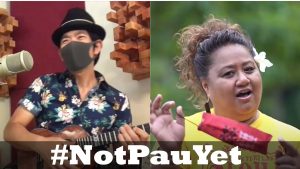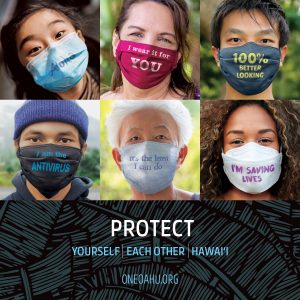The governor’s call to action: ‘We’re not pau yet’
Posted on Aug 27, 2020 in Capitol Connection, FeaturedIf there’s one thing we’ve learned in the past few months, it’s that no one has all the answers to fight COVID-19. That means we’re all part of the solution — from masking up and avoiding large gatherings to ramped-up testing and contact tracing to identify as many cases as possible. This issue highlights some of the state’s latest efforts to get the current community spread of the virus under control at a critical time when we need everyone’s help in this fight. Let’s do this for Hawai‘i.

The Hawaii Department of Defense produced a series of PSAs featuring well-known musicians with the theme “We’re not pau yet.” Photo credit: Hawaii Department of Defense.
Q. What do you want people to know about the most recent steps to limit the spread of COVID-19?
A. We’re attacking community spread of the virus on all fronts. The “Stay at Home, Work from Home” emergency order for O’ahu mandates some of the earlier restrictions from March to drive down the current surge. We’re also working with federal, state and county partners for “surge testing” through Sept. 14 and an expanded contact tracing program, which recently moved to larger quarters at the Hawai‘i Convention Center. Our new Disease Investigation Branch Chief, Dr. Emily Roberson, is putting more efficient systems in place for faster follow-up of cases. We also have added facilities for isolating and quarantining those who need it.
Q. What do you think will make the difference in bringing case numbers down?
A. We want people to understand the wide range of situations that fuel community spread. Prevention is the key, along with effective contact tracing and testing. But contact tracing alone can’t stop a surge in cases. Stopping the spread of the virus has to be everyone’s responsibility. That means taking precautions, even for day-to-day activities that seem low risk and involve close friends and family.

This One Oahu safety campaign from the City and County of Honolulu sends the multi-generational message that we all need to mask up. Photo credit: OneOahu.org
Q. For O‘ahu, what did you and Mayor Caldwell consider in issuing the latest restrictions? What should we all be aware of from recent COVID-19 cases?
A. We decided the stay-at-home order was needed because we were still seeing case counts in the triple digits, which created increased stress on our healthcare system. The mayor has described this as an opportunity to reset. We’re taking a comprehensive approach with surge testing of even asymptomatic people, expanded contact tracing, and isolating family members so they don’t infect others in the household. The important thing is that people can’t let down their guard. Based on recent COVID-19 cases, the sources of infection have ranged from larger social gatherings to smaller groups of co-workers eating lunch together — all without proper safeguards.
Q. What’s important to know about the recent 12th Emergency Proclamation and future CARES Act fund distribution?

“Not Taking Chances”: This campaign from the state Department of Health includes young adults, Pacific Islanders and those who work in service industries. The ads will emphasize the importance of wearing facial coverings and avoiding groups for social gatherings.
A. Our priority continues to be the health and safety of our community, so the mandates we’ve developed support that. We’re extending until Sept. 30 the interisland travel quarantine for those arriving on the neighbor islands as well as the 14-day mandatory travel quarantine. We’re also delaying the start of the pre-travel testing program for trans-Pacific travel, at least until Oct. 1. Pushing back this program means our visitor industry will continue to face challenges so we’re exploring other ways to bring visitors to Hawai‘i safely. This proclamation gives counties the power to create “resort bubbles,” where travelers would be required to stay within a resort area, monitored with a geofencing device until they complete their quarantine. If they leave the property, authorities would be alerted. To help those struggling, we’re moving ahead with plans to provide rental relief, food distribution, and other assistance through CARES funds as well as take advantage of President Trump’s executive order for unemployment benefits.